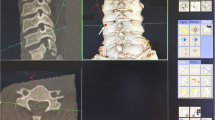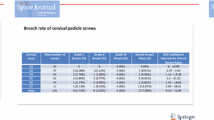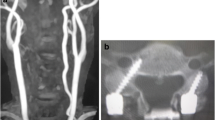Abstract
Purpose
The aim of this study was to analyze the correlation between cervical range of motion and cervical pedicle screw (CPS) misplacement in cervical posterior spinal fusion surgery using a CT-based navigation system.
Methods
A total of 46 consecutive patients with cervical posterior spinal fusion surgery using CPSs were evaluated retrospectively. We analyzed the cervical range of motion (ROM) and the misplacement of CPSs that were placed using either separate or single-time multilevel registration with a CT-based navigation system to determine the optimum registration procedure. The screw-inserted vertebra was indicated as Registered vertebra-Pedicle Screw inserted vertebra (Re-PS) = 0, 1, 2, or 3 depending on its distance (level) from the registered vertebra. Grades 0 (no perforation) and 1 (perforations <2 mm) were categorized as “no misplacement.” Grades 2 (perforations ≧2 mm but < 4 mm) and 3 (perforations ≧ 4mm) were categorized as “misplacement.” We analyzed the correlations between CPS misplacement and Re-PS, and between CPS misplacement and preoperative cervical ROM.
Results
Our analysis included 196 screws in patients having a mean age of 53.2 years (range 5–84 years). Level of insertion relative to registration was Re-PS = 0 in 129 screws, Re-PS = 1 in 53, Re-PS = 2 in 10 and Re-PS = 3 in 4. The misplacement rates were 12.2 % (24 screws) overall, 6.2 % in Re-PS = 0, 22.6 % in Re-PS = 1, 20 % in Re-PS = 2, and 50 % in Re-PS = 3. The rate of CPS misplacement increased significantly with a Re-PS = 1 and a Re-PS = 2 and 3 compared to a Re-PS = 0. There was a significant difference in the cervical ROM in each grade and both misplacement groups: 1.8 in Grade 0, 2.3 in Grade 1, 7.8 in Grade 2, 12.9 in Grade 3, 11 in the misplacement group and 1.9 in the no misplacement group.
Conclusions
The precision of CPS placement in CT-based navigation surgery was evaluated. The misplacement rate in single-time multilevel registration increased to 23.4 % compared to 6.2 % for separate registration. As the distance increased between the registered level and the level of CPS insertion, the preoperative cervical ROM and the rate of CPS misplacement significantly increased. Thus, the rate of misplacement of CPSs is reduced when performing separate registration. Furthermore, when there is greater preoperative cervical ROM, separate registration would likely improve the safety and accuracy of CPS insertion.




Similar content being viewed by others
Abbreviations
- CPS:
-
Cervical pedicle screw
- ROM:
-
Range of motion
- Re-PS:
-
Registered vertebra-pedicle screw inserted vertebra
References
Schlenzka D, Laine T, Lund T (2000) Computer-assisted spine surgery. Eur Spine J 9(Suppl 1):S57–S64
Holly LT, Foley KT (2003) Intraoperative spinal navigation. Spine (Phila Pa 1976) 28:S54–S61
Kotani Y, Abumi K, Ito M, Minami A (2003) Improved accuracy of computer-assisted cervical pedicle screw insertion. J Neurosurg 99:257–263
Richter M, Cakir B, Schmidt R (2005) Cervical pedicle screws: conventional versus computer-assisted placement of cannulated screws. Spine (Phila Pa 1976) 30:2280–2287
Ito H, Neo M, Yoshida M, Fujibayashi S, Yoshitomi H, Nakamura T (2007) Efficacy of computer-assisted pedicle screw insertion for cervical instability in RA patients. Rheumatol Int 27:567–574
Rath SA, Moszko S, Schaffner PM, Cantone G, Braun V, Richter HP, Antoniadis G (2008) Accuracy of pedicle screw insertion in the cervical spine for internal fixation using frameless stereotactic guidance. J Neurosurg Spine 8:237–245
Abumi K, Shono Y, Ito M, Taneichi H, Kotani Y, Kaneda K (2000) Complications of pedicle screw fixation in reconstructive surgery of the cervical spine. Spine (Phila Pa 1976) 25:962–969
Neo M, Sakamoto T, Fujibayashi S, Nakamura T (2005) The clinical risk of vertebral artery injury from cervical pedicle screws inserted in degenerative vertebrae. Spine (Phila Pa 1976) 30:2800–2805
Abumi K, Kaneda K (1997) Pedicle screw fixation for nontraumatic lesions of the cervical spine. Spine (Phila Pa 1976) 22:1853–1863
Scheufler KM, Franke J, Eckardt A, Dohmen H (2011) Accuracy of image-guided pedicle screw placement using intraoperative computed tomography-based navigation with automated referencing, part I: cervicothoracic spine. Neurosurgery 69:782–795 (discussion 795)
Lee TC, Yang LC, Liliang PC, Su TM, Rau CS, Chen HJ (2004) Single versus separate registration for computer-assisted lumbar pedicle screw placement. Spine (Phila Pa 1976) 29:1585–1589
Kalfas IH, Kormos DW, Murphy MA, McKenzie RL, Barnett GH, Bell GR, Steiner CP, Trimble MB, Weisenberger JP (1995) Application of frameless stereotaxy to pedicle screw fixation of the spine. J Neurosurg 83:641–647
Papadopoulos EC, Girardi FP, Sama A, Sandhu HS, Cammisa FP Jr (2005) Accuracy of single-time, multilevel registration in image-guided spinal surgery. Spine J 5:263–267
Conflict of interest
The authors report no conflict of interest concerning the materials or methods used in this study or the findings specified in this paper.
Author information
Authors and Affiliations
Corresponding author
Rights and permissions
About this article
Cite this article
Tauchi, R., Imagama, S., Sakai, Y. et al. The correlation between cervical range of motion and misplacement of cervical pedicle screws during cervical posterior spinal fixation surgery using a CT-based navigation system. Eur Spine J 22, 1504–1508 (2013). https://doi.org/10.1007/s00586-013-2719-3
Received:
Revised:
Accepted:
Published:
Issue Date:
DOI: https://doi.org/10.1007/s00586-013-2719-3




